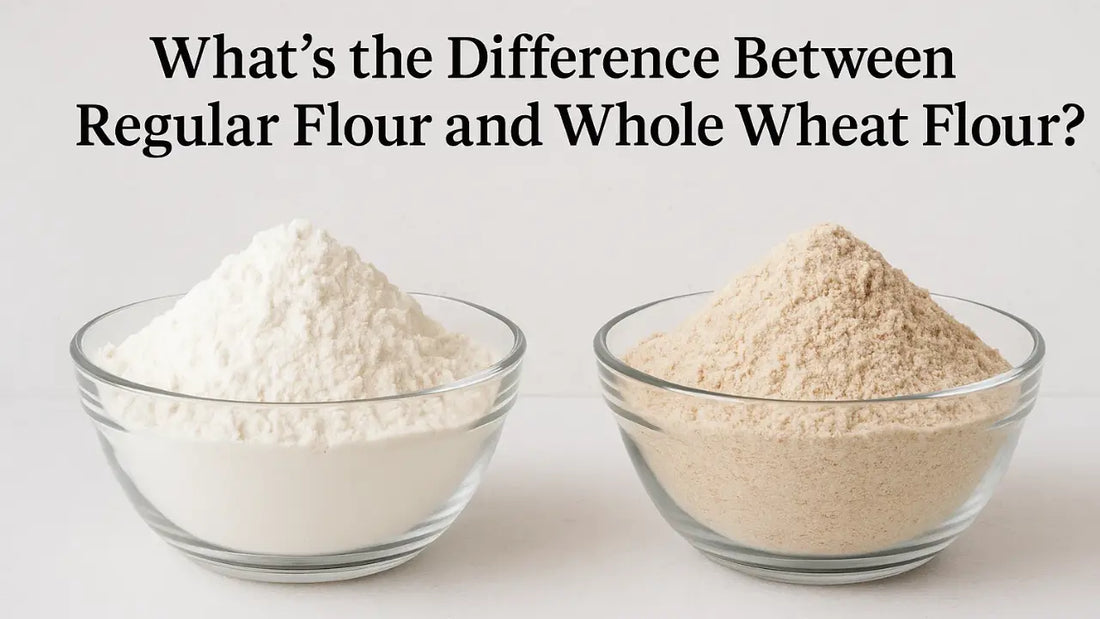
What’s the Difference Between Regular and Whole Wheat Flour?
MOORAV FOODTECH PRIVATE LIMITED AdminShare
When you walk down the grocery aisle, you’ll find many kinds of wheat flour — some labelled regular, others whole wheat. They may look alike, but nutritionally, they are worlds apart.
At 10on10 Foods, we believe that flour should be as natural as the grain itself — full of fibre, nutrients, and wholesome taste. Understanding the difference between regular and whole wheat flour helps you make healthier choices for your family’s daily meals.
What Is Regular Flour?
Regular flour, also known as refined or all-purpose flour (maida), is made by removing the bran and germ the two outer layers of the wheat grain that contain most of its nutrients.
- Whiter and finer in texture
- Longer-lasting on shelves
-
Easier to process for industrial use
However, removing the bran and germ strips away:
- Dietary fibre
- Essential vitamins (like B1, B3, B6)
- Minerals (such as iron, zinc, magnesium)
-
Natural oils and antioxidants
As a result, regular flour is mainly composed of the endosperm — a starch-heavy part of the grain that provides energy but lacks the rich nutrition of the whole wheat kernel.
What Is Whole Wheat Flour?
Whole Wheat Flour, on the other hand, is made by grinding the entire wheat grain — bran, germ, and endosperm together. This keeps all its natural nutrients intact and delivers the true goodness of wheat to your meals.
- Rich in fibre, aiding digestion and gut health
- Packed with vitamins and minerals that support energy, metabolism, and immunity
- Low in glycaemic index, helping maintain balanced blood sugar levels
- Naturally aromatic with a nutty, earthy flavour
At 10on10 Foods, our 100% Whole Wheat Flour is made using carefully selected grains and traditional slow milling. We never blend it with refined flour — ensuring you get purity and nutrition in every spoonful.
The Nutritional Difference at a Glance
|
Component |
Regular (Refined) Flour |
100% Whole Wheat Flour |
|
Parts of Grain Used |
Only the endosperm |
Bran, germ, and endosperm |
|
Fibre Content |
Very low |
High |
|
Vitamins & Minerals |
Lost during refining |
Retained naturally |
|
Taste & Aroma |
Neutral |
Warm and nutty |
|
Texture |
Fine and white |
Slightly coarse, wholesome |
|
Health Impact |
Quick energy, less nutrition |
Sustained energy, better digestion |
How the Body Reacts Differently
Your body digests refined flour much faster, which can lead to quick spikes in blood sugar and hunger soon after eating. Whole wheat flour, being rich in fibre, digests slowly — keeping you full for longer and supporting steady energy release throughout the day.
This difference is why whole wheat flour is linked to better digestion, weight management, and heart health compared to refined flour.
The Taste and Texture You’ll Love
Whole wheat flour has a naturally rich flavour and makes softer, more wholesome rotis, breads, and parathas. It absorbs water better and gives a pleasant aroma when cooked.
Regular flour may give a lighter colour and smoother texture but often lacks the earthy taste and nutritional depth of real whole wheat.
Why Choose 10on10 Foods Whole Wheat Flour?
At 10on10 Foods, we keep things simple and pure.
- Made only from high-quality whole wheat grains
- Stone-ground slowly to retain nutrients and flavour
- Free from refined flour, starch, or artificial additives
-
Freshly milled in small batches for consistent quality
With 10on10 Foods 100% Whole Wheat Flour, you’re not just making a cooking choice, you’re making a health decision for your family.
Frequently Asked Questions About Difference Between Regular and Whole Wheat Flour?
Q1. Can I use whole wheat flour in place of regular flour?
A1. Whole wheat flour can be used in most recipes. It may produce slightly denser dough, but it offers far better nutrition and taste.
Q2. Is whole wheat flour better for weight management?
A2. Its high fibre content keeps you full longer and helps control appetite naturally.
Q3. Why is regular flour so commonly used?
A3. Regular flour has a longer shelf life and a finer texture, which makes it easier for commercial use — but it comes at the cost of nutrition.
Q4. How should I store whole wheat flour?
A4. Store it in an airtight container in a cool, dry place. For longer freshness, you can refrigerate it.

